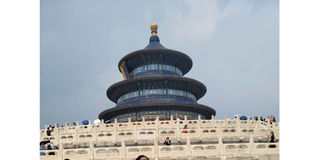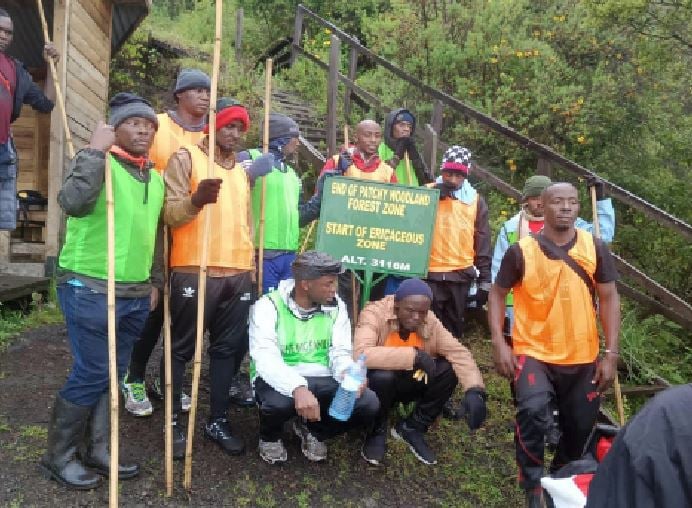Prime
Ancient history meets modernity in Beijing

The Temple of Heaven is of magnificent circular architecture and religious significance. PHOTOS | FAITH AMONGIN
What you need to know:
- The Great Wall. The largest man-made structure in the whole world. It stretches for about 21,000 kilometres across 15 provinces in northern China. Standing atop the ancient stone wall, gave a breathtaking view of mountains and valleys.
In the brisk summer of 2023, my three colleagues and I embarked on a journey that would take us on a tour of China, a land steeped in history and culture. We braved a 19-hour journey from Entebbe that included a five-hour layover in Addis Ababa.
Destination: Beijing, the vibrant capital of the diverse nation of China. With excitement, we set off on an adventure that would take us to some of China’s most iconic landmarks.
When we arrived at the sprawling Beijing Capital International Airport, we were greeted by the humidity of a Beijing summer. The air was crisp, and the streets bustling with locals going about their daily routines. It was an overload of sights, sounds, and smells that immediately immersed us in the rich tapestry of Chinese life.
Summer Palace
Our first stop, a masterpiece of Chinese landscape garden design. The palace complex is centred around Kunming Lake, a large artificial lake made in 1750. The lake is adorned with various bridges, including the iconic Seventeen-Arch Bridge.
Longevity Hill, a man-made hill, is another prominent feature of the complex, with several temples and pavilions on its slopes. As I strolled along the lake and admired the intricate architecture, I imagined the emperors of old, seeking solace and inspiration in the retreat.
The Summer Palace is not only a symbol of China’s imperial history but also a testament to the country’s rich cultural heritage and natural beauty. It continues to attract visitors from around the world who come to appreciate its elegance and historical importance.
Then the Temple of Heaven
This site known for its magnificent circular architecture and religious significance. The next day as the sun began to set, we visited the magnificent temple whose circular design and vibrant colours made it a serene and spiritual experience.
Constructed during the Ming Dynasty in 1420 in the reign of Emperor Yongle, it offers a glimpse into the ancient rituals and beliefs that once played a vital role in the governance of the Chinese empire.
I marvelled at the Hall of Prayer for Good Harvests, a towering structure adorned with vibrant colours and intricate patterns. It was a humbling experience to stand in the same place where emperors once prayed for bountiful harvests and good fortune.
Out of Beijing
Then, we took a two-hour flight from Beijing to the city of Harbin. The city is renowned for its European influences as well as its historical Russian heritage and architecture. It still acts as a significant entry point for Sino-Russian trade.
Renowned for its beautiful winter scenery and ice sculptures, Harbin is a popular tourist destination, especially during the Harbin International Ice and Snow Festival, which is one of the largest festivals in the world. We, however, visited during the summer. While there, we discovered the hidden gem of Yuanbao Village. This quaint village found in Heilongjiang Province was a stark contrast to the bustling metropolis of Beijing. The village of about 1,800 people exuded a tranquil charm. What fascinated me most about it was the innovativeness of the natives.
The Yuanbao villagers, once looked down on as poor now make about 30 million pencils monthly, following a series of reforms by the government, according to Qiu Shuli, the Secretary of the CPC branch of the village.
Back to Beijing
We saved the best for last; The Great Wall. The largest man-made structure in the whole world. It stretches for about 21,000 kilometres across 15 provinces in northern China. Standing atop the ancient stone wall, gave a breathtaking view of mountains and valleys. The wall’s significance was palpable. I marvelled at the incredible human endeavour that built this gem over centuries.

The writer (in blue) attempted climbing the captivating Great Wall.
Our guide, Burton Zhang, told us that more than one million people who were involved in the works died and were buried under the wall as the rest carried on with the construction that was meant to protect them from invaders, more than 2,000 years ago.
“Their bodies were just buried underground so by walking on the wall under the bricks, it’s our ancestors’ bones. So we call the Great Wall the longest cemetery in China,” Zhang said.
The Great Wall receives more than 30,000 tourists worldwide daily.
Trekking its winding path, I felt a deep sense of awe, humbled by the sheer scale of this architectural wonder. Also, as Mao Zedong said in 1935, “You are not a real hero until you climb the Great Wall,” I am happy to report that I am now a certified hero after conquering (part of it) because climbing is not for the weak. At some point, I could not feel my legs and heart. I gasped for breath and sat for a few minutes before taking a few more steps. Otherwise, the essence of my young energetic body would have gone to waste if I had not attempted to climb (wink).
Zhang told us that it would ideally take about two years of walking [climbing] every day to cover the entire distance.
Modern side of Beijing
The city’s bustling streets and futuristic skyline attest to its rapid development. The green policy that caught my attention from when we landed and throughout Beijing cannot miss an honorary mention, it is such a breath of fresh air. Being a developed country and what they are usually known for [pollution], I did not expect that much green but I was taken aback.
As our two-week journey came to an end, we were left with indelible memories of a land where history and tradition seamlessly coexist with modernity. I left with a profound appreciation for this remarkable country and its people. My trip was a captivating chapter in my life story.
Special shout outs to our great hosts at the Research and Training Institute (RTI) of National Radio and Television Administration (NRTA), Zhu Jiadi, Null Sherry, Kathy, Anna and Harold Modante.




